-
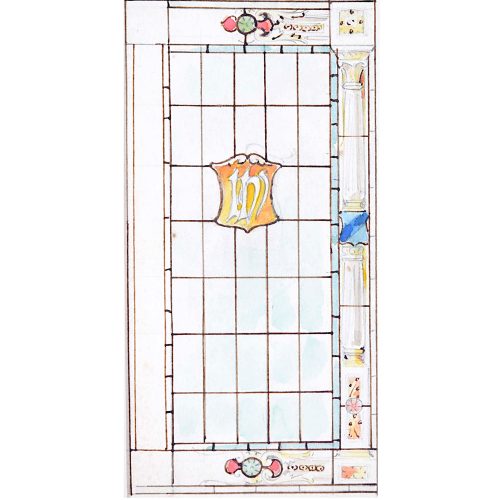
Florence Camm (1874-1960) Design for church stained glass window with 'IHS' roundel
Watercolour 17x9 cm Design for TW Camm & Co., Smethwick, Birmingham With 'IHS' Roundel - 'Iesus Hominum Salvator' ('Jesus Saviour of Mankind') The Camms were stained glass designers who exhibited 48 times at the Royal Academy and also exhibited at The Walker Art Gallery in Liverpool, The Royal Scottish Academy and Royal Birmingham Society of Artists. Following the death of her father, Florence Camm became chief designer at TW Camm with many commissions both nationally and internationally. Florence Camm was the daughter of Thomas William Camm (1839-1912) who founded the stained glass business T W Camm in High Street Smethwick. From 1892-1911 she studied at The Birmingham Municipal School of Art which, unusually for the time, encouraged girls to attend the life drawing classes – drawing fully nude female models and partially draped male models – thus explaining Camm’s skill with the human figure. Students were encouraged to execute their drawings for designs, thus giving them the skills to set up as manufacturers in Birmingham’s Jewellery Quarter. The arts and crafts designer Henry Payne was an influential tutor for Camm, being one of the most influential teachers at the BMSA who was working as a stained glass designer at the time; one of his most notable commissions was a painted mural illustrating Tudor History for the Houses of Parliament in 1908. Following the death of TW Camm, Florence and her brothers – Walter and Robert – took over the business and Florence did most of the designing. If you are interested email info@manningfineart.co.uk or call us on 07929 749056. Condition: In conservation mount and in plastic sleeve for protection. -
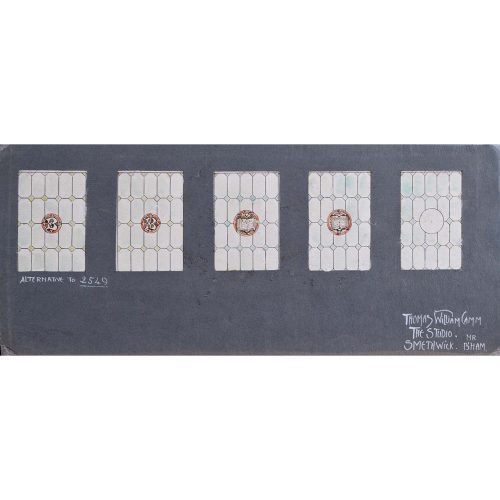
Thomas William Camm Florence Camm Design for 5 Stained Glass Window Panels
Watercolour 15x36 cm For biographical details and other works by the artist click here. If you are interested email info@manningfineart.co.uk or call us on 07929 749056. Conditon: Good. In conservation mount and in plastic sleeve for protection. -
Out of stock
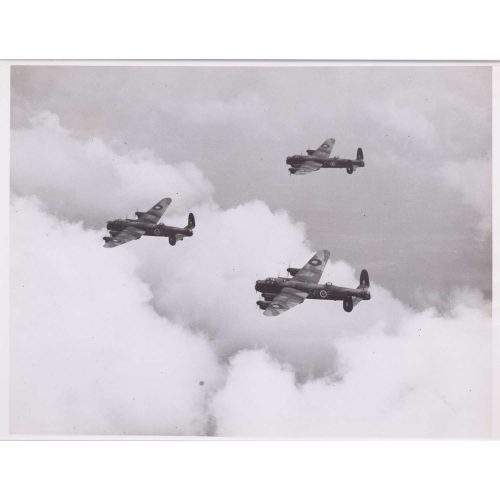
Charles E Brown (1896-1982)
Three AVRO Lancaster Bombers in Flight
Original Silver Gelatin photograph, c. 1944 16 x 21 cm Photograph 20 June 1942 above Cranwell EM-A EM-C and EM-F of 207 Squadron The RAF info website details the various Lancaster bombers of 207 Squadron. EM-C was a Lancaster I with serial number R5695 . It took off on 25 November 1942 from Langar, on a mission to Haselunne. The pilot was an Alfred Parkyn of the RCAF - whose parents lived in New Jersey. The aircraft was lost without trace and the crew are commemorated on the Runneymede Memorial. EM-A was another Lancaster I with serial number ED604. It took off from Langar on 12 March 1943 on a night mission (with 42% moon) to Essen, piloted by the 22-year-old F/O Michael Doble DFC. It crashed near Bottrop on the outskirts of Essen, with the loss of all its crew who are buried in the Reichswald Forest War Cemetery. Doble's DFC was gazetted on 31 July 1942, following an action in which 12 DFCs and one DSO were awarded. The citation reads: "The KING has- been graciously pleased to approve the following awards in recognition of gallantry displayed in flying operations against the enemy: —On 11th July, 1942, a force of bombers was detailed to make an attack on the submarine works at Danzig. The operation, which necessitated a high degree of skill and fortitude, was undertaken in extremely adverse weather. Despite this, the objective was reached by dusk, carefullyidentified and, in the face of strong oppositionfrom the ground defences, subjected to a most determined attack. Bombs were released at varying heights, some as low as 1,000 feet. Many hits were obtained. Searchlight posts were also machine-gunned and many searchlights extinguished. The success achieved reflects the greatest credit on the following personnel who participated in various capacities as leaders and members of aircraft crews." EM-F was a Lancaster I serial number R5694, piloted by Flight Lieutenant Raymund Joseph Hannan DFC which hit high ground in bad visibility at Easton, Lincs, home-bound from Bad Zwischenahn (Vechta) killing all the crew on 25 November 1942. Hannan was a New Zealander who had served for a year with the RNZAF prior to volunteering in September 1939 for the RAF. Following training he undertook a tour of 29 operations with 49 Squadron in the Handley Page Hampden, and after this served as an instructor in 25 Operational Training Unit. His DFC was gazetted on 24 October 1941. In September 1942 he was posted to 207 Squadron, flying four missions prior to that of 25 November 1942. This latter mission lasted only three hours - probably long enough to reach the Dutch coast and return to the UK, and certainly not long enough for the Luftwaffe aerodrome at Bad Zwischenahn. Upon return to base the aeroplane was unable to land owing to bad weather. It crashed near Goadby Marwood, the local history society of which have published an extensive history of the crew members at https://www.goadby-marwood-history.co.uk/the-crew-of-r5694-em-f . Five of the crew, including Hannan, are buried in St Mary's Churchyard in Bottesford. The crash site was discovered in 2021, a full report here: https://www.goadby-marwood-history.co.uk/_files/ugd/bc525f_aedab371f8794f2eab2c0c9ea9721720.pdf The grave sites of the crew members are detailed here https://aviationtrails.wordpress.com/tag/r5694/ Charles E Brown was a famous photographer of aircraft whose father was a butcher in Wimbledon, London. Young Charles was given a camera for his 14th birthday and in 1911 photographed an Edwardian gentleman in trouble landing his balloon in neighbouring Southfields. This photograph was published in the Daily Mirror – the fee being half a crown – and Brown was encouraged to join the Daily Mirror’s photography department upon leaving school at 16. Towards the end of the First World War he served with the Royal Air Force at their official London Photographic Centre. Following the war, he took to photographing trains, and captured a famous photograph of a Southern Railway locomotive that was used for the following ten years in railway posters. The income from this allowed him to pursue his passion of aviation photography in the 1920s and 1930s, from which commissions from the Air Ministry and Fleet Air Arm followed. During the war his work included commissions for Aeronautics magazine. Provenance: from the collection of Philip J R Moyes, author of many books on the RAF, most notably The Pictorial History which ran to several volumes. Condition: Generally very good. -
Out of stock
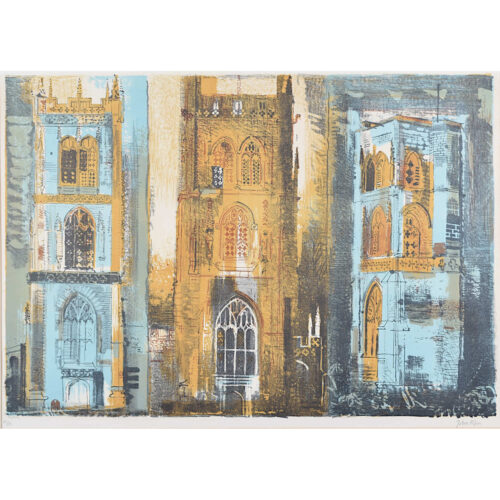
John Piper (1903-1992)
Three Somerset Towers (1973)
Screenprint 56 x 76 cm John Piper CH was an English painter, printmaker, and designer of stained-glass windows. His work often focused on the British landscape, especially churches and monuments, and included tapestry designs, book jackets, screen-prints, photography, fabrics and ceramics. Condition: generally very good; a little age toning. If you are interested, please email info@manningfineart.co.uk or call us on 07929 749056. Click here for other works by John Piper. -
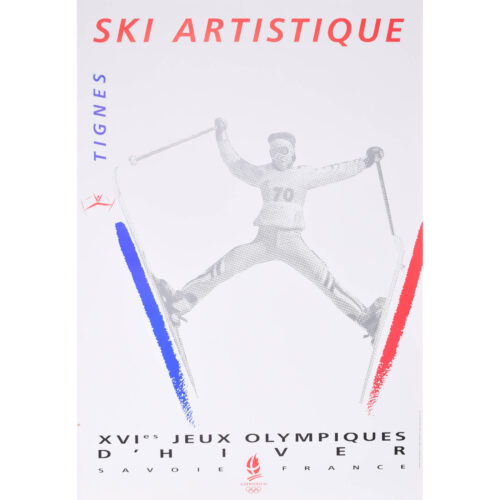
R C Meaux
Tignes - Ski Artistique (1990)
Original vintage poster 80 x 53 cm An original vintage poster printed in colour in 1990 by L’Avenir Graphic. The poster was designed to promote the 1992 Olympic Winter Games in Albertville. A similar design was also used for a limited edition French postage stamp in 1992. Condition: very good. If you are interested, please email info@manningfineart.co.uk or call us on 07929 749056. Click here for more original vintage ski posters. -
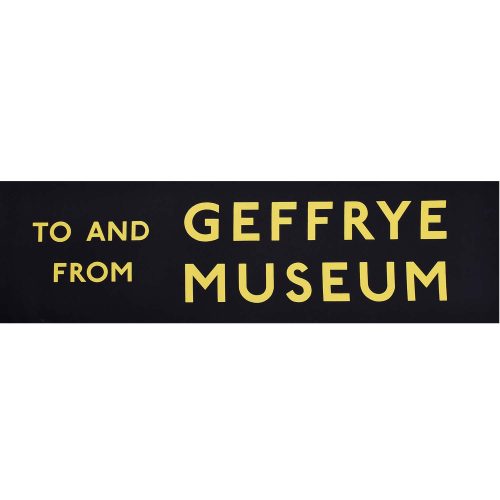
To and From Geffrye Museum Routemaster Bus Slipboard Poster c1970
Screenprint poster 64x19cm Printed for London Transport for use on Routemaster or RT busses. Geffrye Museum is the museum of the home. If you are interested email info@manningfineart.co.uk or call us on 07929 749056. Condition: Good. -
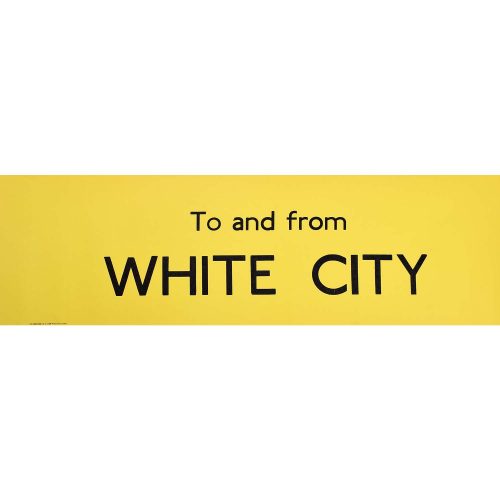
To and From White City Routemaster Bus Slipboard Poster c1970
Screenprint poster 64x19cm Printed for London Transport for use on Routemaster or RT busses. If you are interested email info@manningfineart.co.uk or call us on 07929 749056. Condition: Good. -
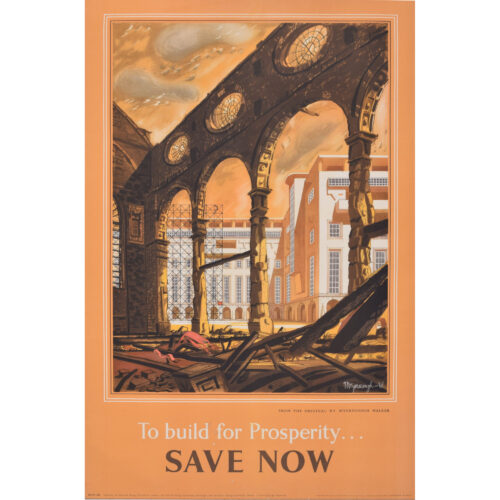
Raymond Myerscough Walker (1908 - 1984)
To Build for Prosperity - Save Now
Original vintage poster 74 x 49 cm Issued by the National Savings Committee London, the Scottish Savings Committee Edinburgh, and the Ulster Savings Committee Belfast. Printed For HM Stationery Office By Thomas Forman and Sons Ltd, Nottingham. This posters makes use of Myerscough Walker's original painting of a church bombed in the Blitz, with new buildings being constructed behind. Even in the face of war and destruction, Britain builds itself up to prosper - and, by saving, so can we. Myerscough Walker was an architectural draughtsman. He trained at Leeds School of Art and went on to the Architectural Association in London. In 1931 he won the Tite prize and was celebrated in his career for his skill as a draughtsman – as well as architect, writer, artist, sculptor and stage designer. He worked with Berhold Lubetkin, the significant modernist architect, for several years. Condition: generally very good; the odd gentle crease. Not backed. If you are interested, please email info@manningfineart.co.uk or call us on 07929 749056. Click here for other original vintage posters. -
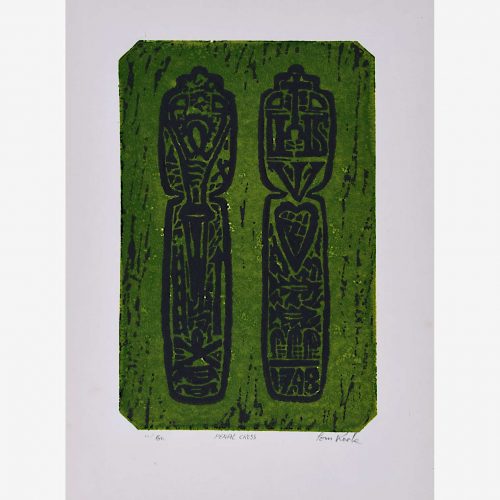
Tom Roche (b. 1940) Penal Cross
Screenprint 24x19cm Signed in pencil and numbered 11/40 Roche trained at the Irish National College of Art and Design, then studying etching and lithography at Chelsea College of Art. After working as a graphic designer in advertising, he became a full-time painter in 1972 based in Dingle in Co. Kerry. After operating from a gallery in Dingle he returned in the 1980s to Dublin, working as part0time lecturer at the Dun Laoghaire School of Art and Design and as creative director for Emerald City Productions Ltd. He is renowned for his soft, atmospheric paintings of Irisih landscape and interiors as well as for his prints such as this. If you are interested email info@manningfineart.co.uk or call us on 07929 749056. -
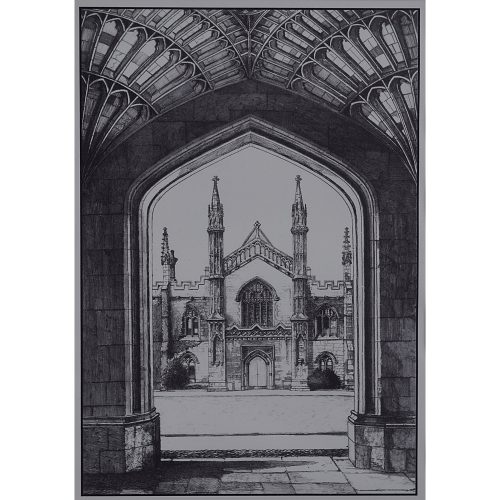
Tony Broderick (British, late 20th Century) Corpus Christi College Cambridge
Print 35x25cm A Lincoln-based artist, known for his portrayal of Lincoln and also of the Cambridge Colleges. If you are interested email info@manningfineart.co.uk or call us on 07929 749056. Condition: Excellent. -
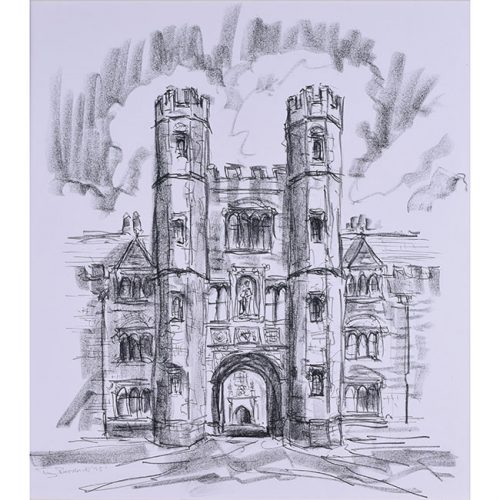
Tony Broderick
Shrewsbury Tower St. John's College Cambridge
Conte drawing 35x32cm If you are interested email info@manningfineart.co.uk or call us on 07929 749056. -

Tony Broderick
St. John's Great Gate, Cambridge
Conte drawing 33x42cm If you are interested email info@manningfineart.co.uk or call us on 07929 749056. -
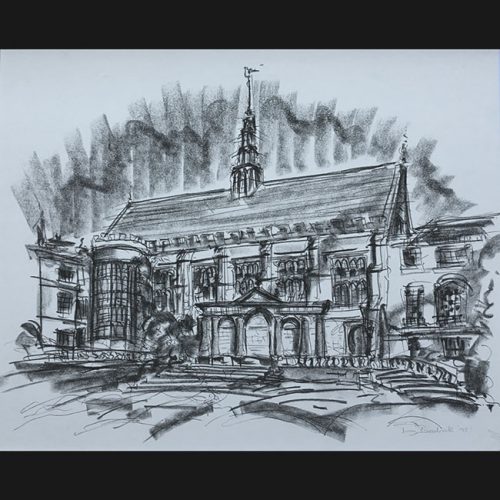
Tony Broderick
Trinity College, Cambridge, Hall from exterior
Conte drawing 37x47cm If you are interested email info@manningfineart.co.uk or call us on 07929 749056. -
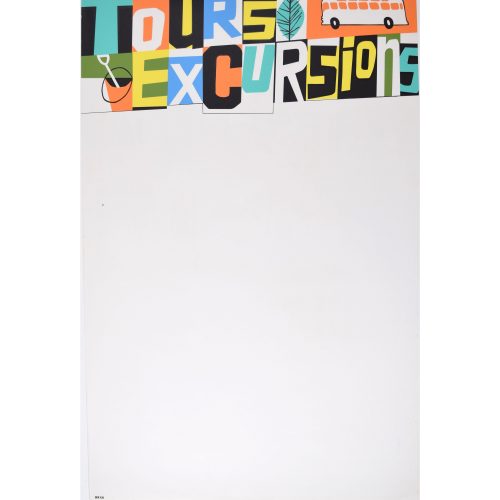
Anonymous Tours and Excursions
Original Coach Poster 75x50cm Cool and crazy mid-century lettering. Poster with area for completion with details of a coach tour. If you are interested email info@manningfineart.co.uk or call us on 07929 749056. Condition: Excellent. -
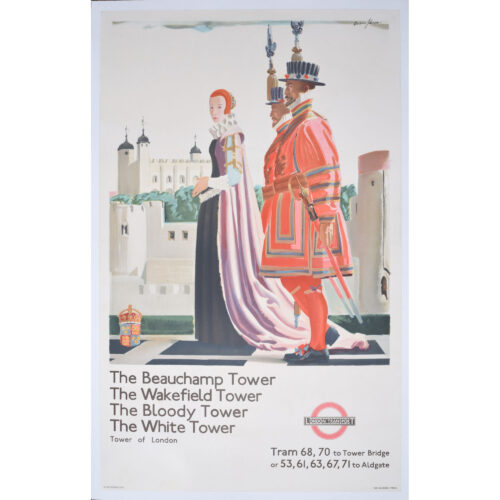
Andrew Johnson (1893 - 1973)
The Tower of London (1935)
Lithograph 102 x 64 cm A copy of this poster is held by the London Transport Museum (1983/4/4178). Queen Elizabeth I, accompanied by two Yeomen Warders, surveys the white stone of the Tower of London. Johnson's design encourages us to use London Transport (now Transport for London) to visit the Tower in all its historic glory. Andrew Johnson was born in Portsmouth and studied at the Central School of Art and Design (now Central St Martin's) in London. He worked as a poster designer for several advertising agencies. He designed posters for BP, Shell, the London and North Eastern Railway, Southern Railway, The Times, and General Motors (to name but a few). He made advertising graphics in New York in the late 1920s and later founded Grainger Johnson (a poster design company) with Tom Grainger. He was a member of the British Society of Poster Designers and several of his designs are held by the London Transport Museum. Condition: backed to linen; excellent. If you are interested, please email info@manningfineart.co.uk or call us on 07929 749056. Click here for other original vintage posters. -
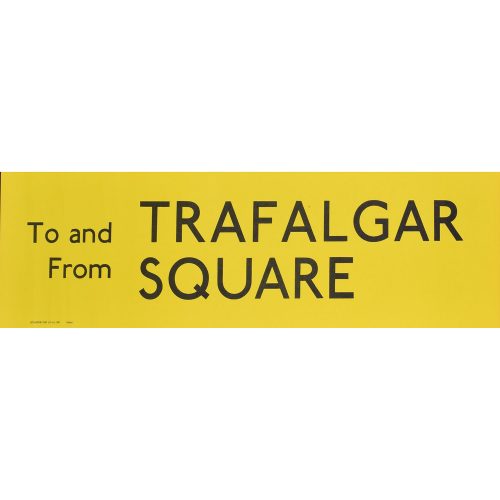
Trafalgar Square Routemaster Slipboard Poster c1970
Screenprint poster 64x19cm Printed for London Transport for use on Routemaster or RT busses. If you are interested email info@manningfineart.co.uk or call us on 07929 749056. -
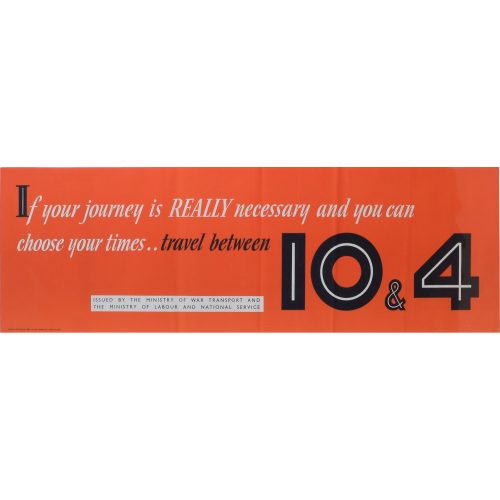
Printed for H.M. Stationery Office, c.1943
If your journey is REALLY necessary and you can choose your times… travel between 10 and 4
Issued by the Ministry of War Transport and the Ministry of Labour and National Service 18×75 cm (7″ x 30″) in unissued condition If you are interested email info@manningfineart.co.uk or call us on 07929 749056. -
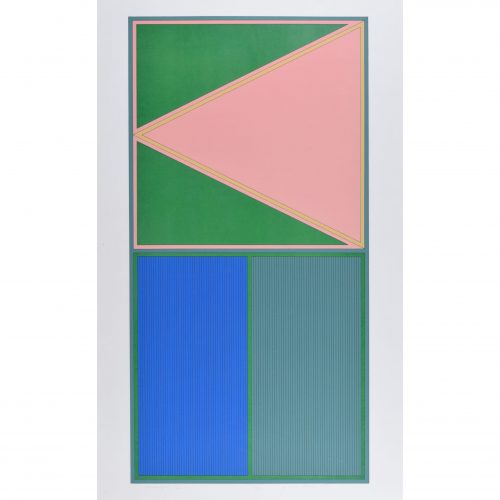
Gordon House (1932 - 2004)
Triangle D
Lithograph 86 x 45 cm Signed and titled in pencil below the plate. An excellent example of Gordon House's work: a modern design in tones of green, pink, and blue. Gordon House was born in Pontardawe, South Wales in 1932 and studied at Luton and St. Albans Schools of Art. He began working for advertising agencies in the 1950s and became a full-time artist in 1961, exhibiting several solo shoes. He designed for several leading London galleries, the Ashmolean Museum in Oxford, and popular bands such as the Beatles and the Rolling Stones. Several dozen Gordon House prints are held by the Tate. Condition: very good; backed to board. If you are interested, please email info@manningfineart.co.uk or call us on 07929 749056. Click here for other abstract lithographs by Gordon House. -

Gordon House (1932 - 2004)
Triangle E
Lithograph 86 x 45 cm Signed and titled in pencil below the plate. An excellent example of Gordon House's work: a modern design in several tones of blue. Gordon House was born in Pontardawe, South Wales in 1932 and studied at Luton and St. Albans Schools of Art. He began working for advertising agencies in the 1950s and became a full-time artist in 1961, exhibiting several solo shoes. He designed for several leading London galleries, the Ashmolean Museum in Oxford, and popular bands such as the Beatles and the Rolling Stones. Several dozen Gordon House prints are held by the Tate. Condition: very good. Mounted to board. If you’d like to know more, please email info@manningfineart.co.uk or call us on 07929 749056. -
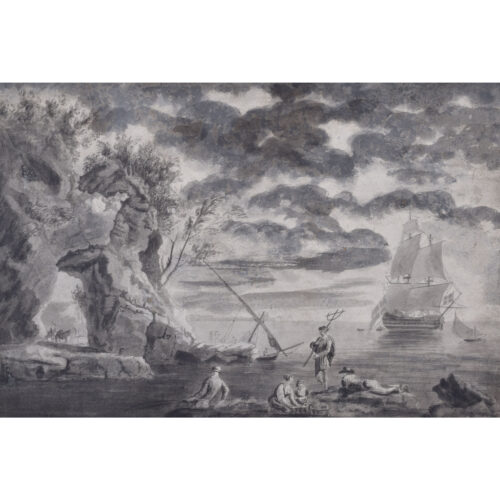
John Cantiloe Joy (1805 - 1859) / William Joy (1803 - 1865) (attributed)
Trident on the Shore
Pencil and wash 28 x 42 cm A 19th century engraving of a ship near a shore. Various figures, including one wielding a trident, appear in the foreground. John Cantiloe Joy and William Joy were brothers who worked together as English marine artists. During the 1820s, the brothers' paintings were exhibited at the Norwich Society of Artists, the Royal Society of British Artists, the Royal Academy and at the British Institution. They belonged to the Norwich School of painters which specialised in maritime scenes and views of rural Norfolk and Norwich. Condition: generally very good; mounted to board. If you are interested, please email info@manningfineart.co.uk or call us on 07929 749056. -
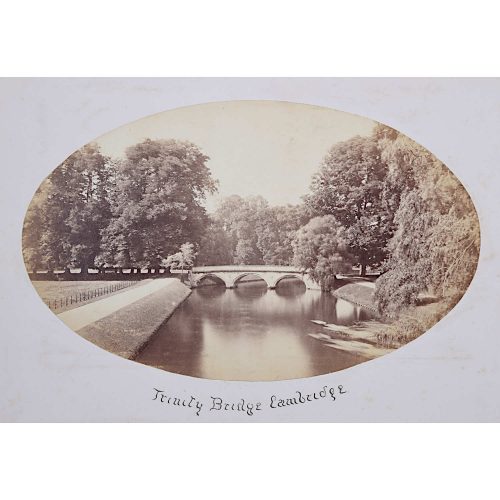
Trinity Bridge, Cambridge
Albumen print of a photograph, circa 1850 Mounted to board and inscribed 'Trinity Bridge Cambridge'. Trinity Bridge is a stone built tripled-arched road bridge across the River Cam. It was built from Portland stone in 1765 to the designs of James Essex to replace an earlier bridge built in 1651, and is a Grade I listed building. Trinity College is a constituent college of the University of Cambridge, and was founded in 1546 by King Henry VIII. Trinity is one of the oldest and largest colleges in Cambridge, with the largest financial endowment of any college at either Cambridge or Oxford. Trinity has some of the most distinctive architecture within Cambridge, with its Great Court reputed to be the largest enclosed courtyard in Europe. Condition: generally very good. If you’d like to know more, please email info@manningfineart.co.uk or call us on 07929 749056. -
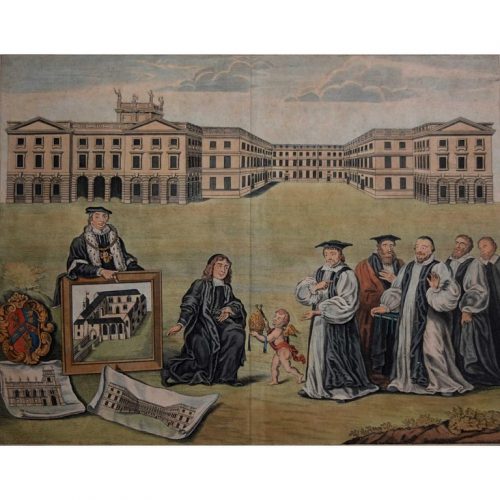
Engraving of architect showing plans of Trinity College Oxford and its chapel, behind larger elevation of Garden (early 18th Century)
Hand coloured engraving, anoymous 36.5 x 47.5 cm Rare - we have been unable to identify another copy of this print. The architect pictured has been suggested to be Henry Aldrich who designed the chapel at Trinity College, hence seen here with the plans thereof. The figures stand before the buildings of the Garden Quadrangle, built by Christopher Wren. Aldrich was Canon and Dean of Christ Church, Oxford. As well as a polymath and composer, he was a prolific architect working in the Palladian style, writing 'Elemena Architectuae Civilis' (1789) and designing Peckwater Quadrangle at Christ Church (1707-14). Condition:Generally good with some spotting and slight overall toning. Trimmed to just within platemark at top and bottom. If you are interested email info@manningfineart.co.uk or call us on 07929 749056. -
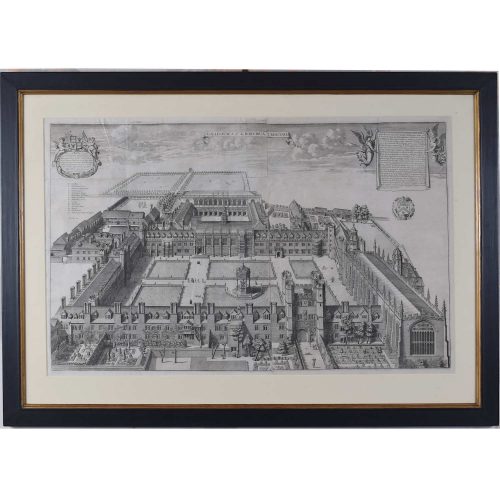
David Loggan (1634 - 1692)
Trinity College, Cambridge (1690)
Engraving 80 x 50 cm Loggan was born to English and Scottish parents, and was baptised in Danzig in 1634. After studying engraving in Danzig with Willem Hondius (1598-1652 or 1658), he moved to London in the late 1650s, going on to produce the engraved title-page for the folio 1662 Book of Common Prayer. He married in 1663 and moved to Nuffield in Oxfordshire in 1665. Loggan was appointed Public Sculptor to the nearby University of Oxford in the late 1660s, having been commissioned to produce bird’s-eye views of all the Oxford colleges. He lived in Holywell Street as he did this. The 'Oxonia Illustrata' was published in 1675, with the help of Robert White (1645 - 1704). Following its completion, Loggan began work on his equivalent work for Cambridge; the 'Cantabrigia Illustrata' was finally published in 1690, when he was made engraver to Cambridge University. The 'Oxonia Illustrata' also includes an engraving of Winchester College (Winchester and New College share William of Wykeham as their founder) whilst the 'Cantabrigia Illustrata' includes one of Eton College (which shares its founder, Henry VIII, with King’s College). Bird’s-eye views from this era required a particular talent as an architectural perspectivist; it was not until 1783 that it became possible for artists to ascend via hot air balloons and view the scenes they were depicting from above. Loggan thus had to rely on his imagination in conceiving the views. Loggan’s views constitute the first accurate depictions of the two Universities, in many ways unchanged today. Whilst the Oxford engravings were produced in reasonable numbers and ran to a second edition by Henry Overton (on thicker paper and with a plate number in Roman numerals in the bottom right-hand corner), those of Cambridge were printed in much smaller numbers. The Dutchman Pieter van der Aa published some miniature versions of the engravings for James Beverell’s guidebook to the UK, 'Les Delices de la Grande Bretagne' (circa 1708). The contemporary artist Andrew Ingamells has produced a highly-acclaimed series of etchings which bring Loggan’s original vision up to date. Condition: generally very good; printed on two sheets, folds as issued. A few creases to top area. As a multi-folded plate in the published book, Trinity has normally suffered and is normally trimmed closely and has damage; this particular example has instead good margins outside the platemark and without damage to the folds. A very good copy of Trinity. If you’d like to know more, please email info@manningfineart.co.uk or call us on 07929 749056. -
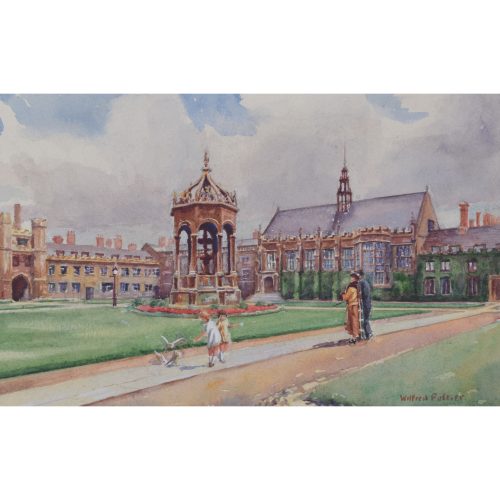
Wilfred Pettitt (1904 - 1978)
Great Court, Trinity College, Cambridge
Watercolour 17 x 27 cm A smartly-dressed couple and their two children enjoy the sunny and immaculately-lawned Great Court of Trinity College, Cambridge. The man and woman admire the ornate fountain which stands sentinel in the middle of the court (it, along with the rest of Great Court, was erected by by Thomas Nevile, master of the college in the early 17th century). Their children, perhaps oblivious to the architectural majesty around them, amuse themselves by playing with the pigeons. Wilfred Stanley Pettitt was born in Great Yarmouth, and studied at the Great Yarmouth School of Art and the Norwich School of Art. In 1928 he showed at the Royal Academy Royal Academy for the first time, and his work was also exhibited by the Royal Society of British Artists and the Royal Cambrian Academy. In 1944 Pettitt became one of the founding members of the Norwich Twenty Group (a group of Norfolk artists who intended to raise the standards of local professional art). He died in Eastbourne in 1978. Condition: mounted to board; otherwise very good. If you are interested, please email info@manningfineart.co.uk or call us on 07929 749056. Click here for other views of Trinity College, Cambridge. -
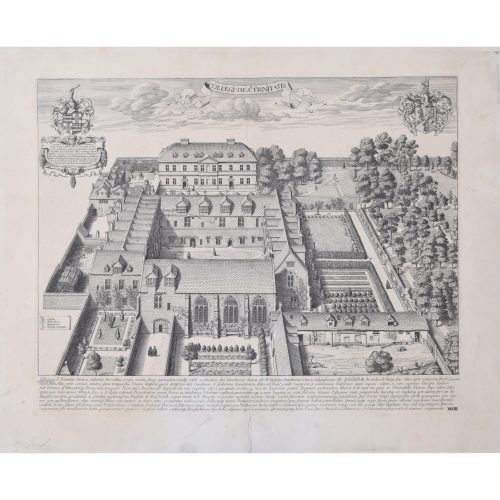
David Loggan (1634 - 1692)
Trinity College, Oxford (1705)
Engraving 32 x 41 cm Loggan's view of Trinity from the second edition of the 'Oxonia Illustrata'. Loggan was born to English and Scottish parents, and was baptised in Danzig in 1634. After studying engraving in Danzig with Willem Hondius (1598-1652 or 1658), he moved to London in the late 1650s, going on to produce the engraved title-page for the folio 1662 Book of Common Prayer. He married in 1663 and moved to Nuffield in Oxfordshire in 1665. Loggan was appointed Public Sculptor to the nearby University of Oxford in the late 1660s, having been commissioned to produce bird’s-eye views of all the Oxford colleges. He lived in Holywell Street as he did this. The 'Oxonia Illustrata' was published in 1675, with the help of Robert White (1645 - 1704). Following its completion, Loggan began work on his equivalent work for Cambridge; the 'Cantabrigia Illustrata' was finally published in 1690, when he was made engraver to Cambridge University. The 'Oxonia Illustrata' also includes an engraving of Winchester College (Winchester and New College share William of Wykeham as their founder) whilst the 'Cantabrigia Illustrata' includes one of Eton College (which shares its founder, Henry VIII, with King’s College). Bird’s-eye views from this era required a particular talent as an architectural perspectivist; it was not until 1783 that it became possible for artists to ascend via hot air balloons and view the scenes they were depicting from above. Loggan thus had to rely on his imagination in conceiving the views. Loggan’s views constitute the first accurate depictions of the two Universities, in many ways unchanged today. Whilst the Oxford engravings were produced in reasonable numbers and ran to a second edition by Henry Overton (on thicker paper and with a plate number in Roman numerals in the bottom right-hand corner), those of Cambridge were printed in much smaller numbers. The Dutchman Pieter van der Aa published some miniature versions of the engravings for James Beverell’s guidebook to the UK, 'Les Delices de la Grande Bretagne' (circa 1708). The contemporary artist Andrew Ingamells has produced a highly-acclaimed series of etchings which bring Loggan’s original vision up to date. Condition: generally very good; second edition. If you’d like to know more, please email info@manningfineart.co.uk or call us on 07929 749056. -
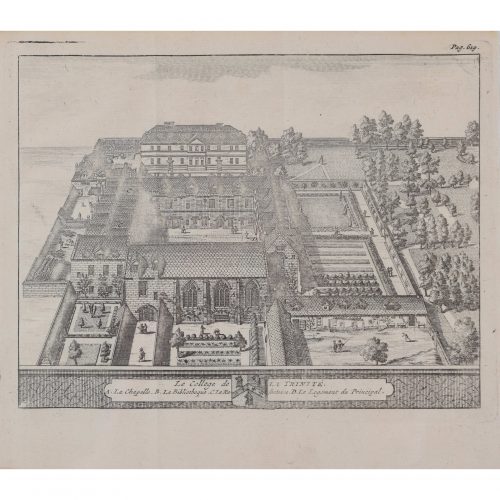
Pieter van der Aa (1659-1733), after David Loggan (1634–1692)
Trinity College, Oxford (1727)
Engraving 12 x 16 cm An eighteenth-century view of Trinity College, engraved by Pieter van der Aa after David Loggan, the noted engraver, draughtsman, and painter who specialised in engravings of Oxford and Cambridge. Pieter van der Aa of Leiden was a Dutch publisher best known for preparing maps and atlases, though he also printed editions of foreign bestsellers and illustrated volumes. He is noted for the many engravings he produced after David Loggan's series of Oxford and Cambridge colleges and costumes. In 1727 Van Der Aa illustrated "Les Delices de la Grande Bretagne & de L'Irelande" by James Beeverell, the book in which this engraving appears. Condition: a good impression. If you’d like to know more, please email info@manningfineart.co.uk or call us on 07929 749056. -
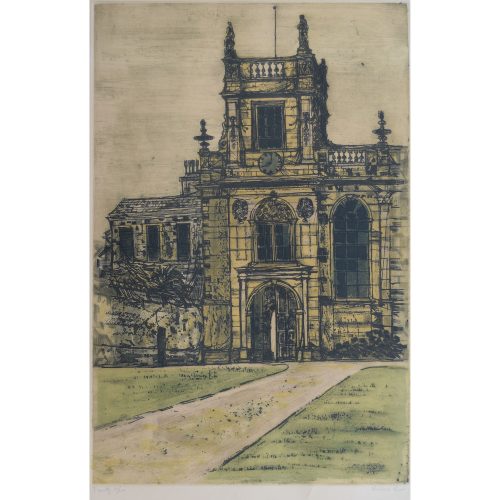
Richard Beer (1928 - 2017)
Trinity College, Oxford (1964 / 65)
Etching and aquatint 42.5 x 58 cm Numbered 27 / 100. Published by Editions Alecto. A copy of this print, owned by the Government Art Collection, is currently in the British Embassy in Saudi Arabia. Richard Beer was a painter and printmaker who focused on architecture and landscapes. He studied at the Slade School of Art from 1945 to 1950 and then studied at the École des Beaux Arts in Paris on a French Government Scholarship. He then worked and studied at Atelier 17, an art school and studio run by the artist Stanley William Hayter (arguably one of the most significant printmakers of the 20th century). The atelier was highly influential in the study and promotion of 20th-century printmaking, and it was here that Beer developed his etching skills. Beer then went on to work for the Royal Ballet choreographer John Cranko, designing the sets and costumes for "The Lady and the Fool" at the Royal Opera House in Covent Garden. He also produced several book illustrations and book jacket designs. Beer taught printmaking at the Chelsea School of Art for 40 years and was also a founding member of the Printmakers' Council. He travelled widely through Italy, France, Spain, and Morocco, sketching prolifically and painting rural and architectural landscapes. Beer would then make etchings and paintings in his Primrose Hill studio, inspired by the landscapes he had sketched and seen while travelling. Probably his greatest work was a collaboration with John Betjeman to produce a portfolio of prints of ten Wren Churches in the City of London for Editions Alecto, copies of which are in The Government Art Collection. That collection contains a total of 54 prints by Beer, and the Tate Gallery’s collection holds another seven. His series of Oxford architectural engravings was also produced for Editions Alecto, as was a series of predominantly architectural views in Southern Europe. If you are interested, please email info@manningfineart.co.uk or call us on 07929 749056. Click here for other views of Trinity College, Oxford. -
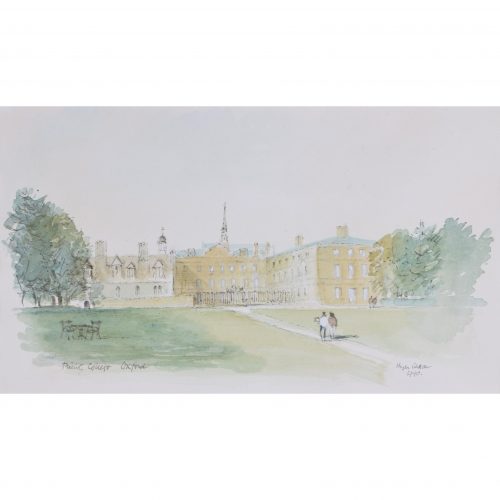
Hugh Casson (1910 - 1999)
Trinity College, Oxford (1990)
Watercolour 20 x 33 cm (38 x 50 cm framed) Casson's marvellous watercolour of Trinity and its perfectly manicured lawns, adorned with strolling undergraduates. Sir Hugh Casson was educated at Eastbourne College; St John’s College, Cambridge; and the Bartlett School of Architecture. Trained in the 1930s in the early modernist style, he taught at the Cambridge School of Architecture. After employment as a camoufleur during World War 2 by the Air Ministry, in 1948 he was appointed as director of architecture for the Festival of Britain. A close friend of the Royal Family, he undertook designs for the 1953 coronation, designed the interior of the Royal Yacht Britannia (“The overall idea was to give the impression of a country house at sea”), and taught the young Charles III to paint in watercolours. Amongst his architectural achievements are the Elephant House at London Zoo, the 1978 redevelopment of Bristol Docks, the Raised Staff Building for The University of Cambridge, and a building for the Royal College of Art. He published a number of illustrated books, of which Casson’s Oxford and Casson’s Cambridge are probably the best known. A limited edition series of prints was produced from the paintings. Condition: excellent. If you’d like to know more, please email info@manningfineart.co.uk or call us on 07929 749056. Click here for other views of Trinity College, Oxford. -
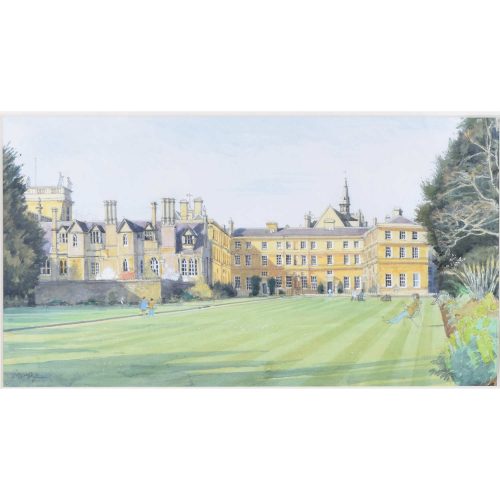
John Doyle (born 1928)
Trinity College, Oxford
Watercolour 24 x 46 cm Signed lower left. Doyle's striking portrayal of Trinity's architecture, complete with undergraduates variously strolling, sitting, and reading in the foreground. Afternoon sun slants over the immaculately mown lawns. John Doyle was born in London and works in watercolours, pastels, and oils. He studied at the Maidstone School of Art in his 30s, later showing at the Royal Academy Summer Exhibition. Much of his work focuses on landscape and architecture; he has produced a series of views of Oxford and its colleges. Condition: excellent. If you’d like to know more, please email info@manningfineart.co.uk or call us on 07929 749056. Click here for more views of Trinity College, Oxford. -
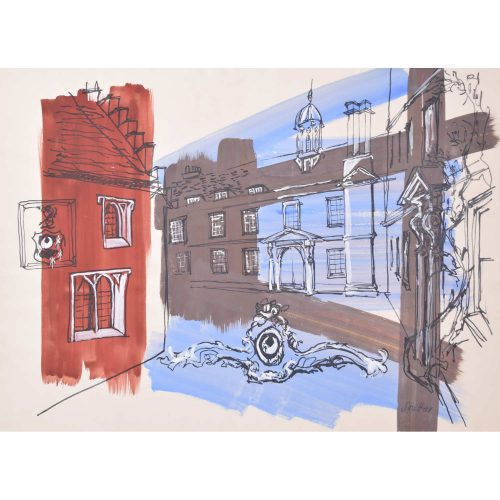
Margaret Souttar (1914 - 1987)
Trinity Hall, Cambridge I
Acrylic paint 55 x 76 cm Signed in pencil lower right. Souttar was a Scottish painter and printmaker known for her images of town- and cityscapes. In the early 1960s, she was commissioned to produce a series of prints of the Cambridge colleges. She captures the modernity and optimism of 1960s Cambridge; the fact that a female artist was commissioned to create the prints reflects the changing attitudes of the University towards women. Trinity Hall was one of the first Cambridge colleges to admit women as students - it did not do so until 1976. Provenance: the artist's studio sale. Condition: generally very good, a few handling marks. If you are interested, please email info@manningfineart.co.uk or call us on 07929 749056. Click here for other views of Trinity Hall. -
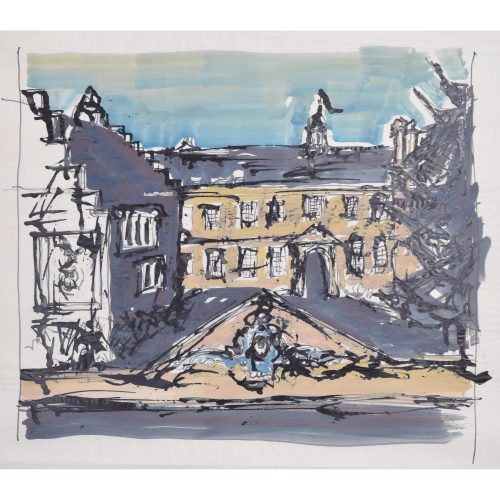
Margaret Souttar (1914 - 1987)
Trinity Hall, Cambridge II
Acrylic paint 56 x 65 cm cm Souttar was a Scottish painter and printmaker known for her town- and cityscapes. In the early 1960s, she was commissioned to produce a series of prints of the Cambridge colleges. She captures the modernity and optimism of 1960s Cambridge; the fact that a female artist was commissioned to create the prints reflects the changing attitudes of the University towards women. Trinity Hall was one of the first Cambridge colleges to admit women as students – it did not do so until 1976.6. Provenance: the artist's studio sale. Condition: generally very good, some crinkling as a result of using water-based paints on thin paper. If you are interested, please email info@manningfineart.co.uk or call us on 07929 749056. Click here for other views of Trinity Hall. -
Out of stock
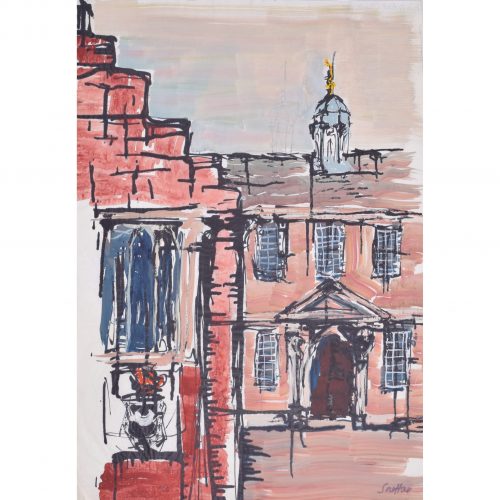
Margaret Souttar (1914 - 1987)
Trinity Hall, Cambridge IV
Acrylic paint 62 x 92 cm Signed lower right. Souttar was a Scottish painter and printmaker known for her images of town- and cityscapes. In the early 1960s, she was commissioned to produce a series of prints of the Cambridge colleges. She captures the modernity and optimism of 1960s Cambridge; the fact that a female artist was commissioned to create the prints reflects the changing attitudes of the University towards women. Trinity Hall was one of the first Cambridge colleges to admit women as students – it did not do so until 1976. Provenance: the artist's studio sale. Condition: generally very good; on thin paper - some crinkling to paper as a result of being painted. Further sketch to reverse. If you are interested, please email info@manningfineart.co.uk or call us on 07929 749056. Click here for other views of Trinity Hall. -
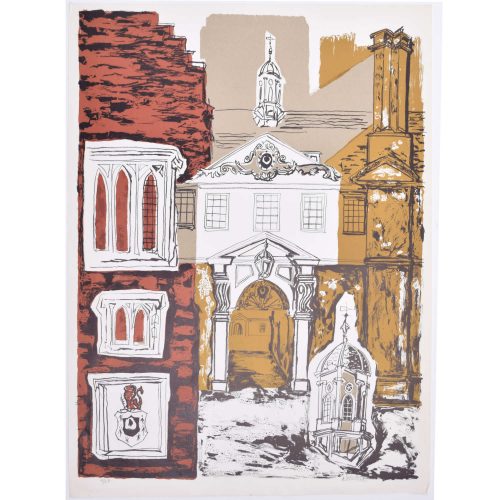
Margaret Souttar (1914 - 1987)
Trinity Hall, Cambridge
Lithograph 76 x 56 cm Signed and numbered 4/50 in pencil. Souttar was a Scottish painter and printmaker known for her images of town- and cityscapes. In the early 1960s, she was commissioned to produce a series of prints of the Cambridge colleges. She captures the modernity and optimism of 1960s Cambridge; the fact that a female artist was commissioned to create the prints reflects the changing attitudes of the University towards women. Trinity Hall was one of the first Cambridge colleges to admit women as students - it did not do so until 1976. Provenance: the artist's studio sale. Condition: generally very good; a few handling marks. If you are interested, please email info@manningfineart.co.uk or call us on 07929 749056. Click here for other views of Trinity Hall. -

Margaret Souttar (1914-1987)
Trinity Hall, Cambridge
Acrylic on paper 76 x 56 cm Signed lower right. Souttar was a Scottish painter and printmaker known for her images of town- and cityscapes. In the early 1960s, she was commissioned to produce a series of prints of the Cambridge colleges. She captures the modernity and optimism of 1960s Cambridge; the fact that a female artist was commissioned to create the prints reflects the changing attitudes of the University towards women. Trinity Hall was one of the first Cambridge colleges to admit women as students - it did not do so until 1976. Provenance: the artist's studio sale. Condition: generally very good; some small glue stains around collaging. If you are interested, please email info@manningfineart.co.uk or call us on 07929 749056. Click here for other views of Trinity Hall. -
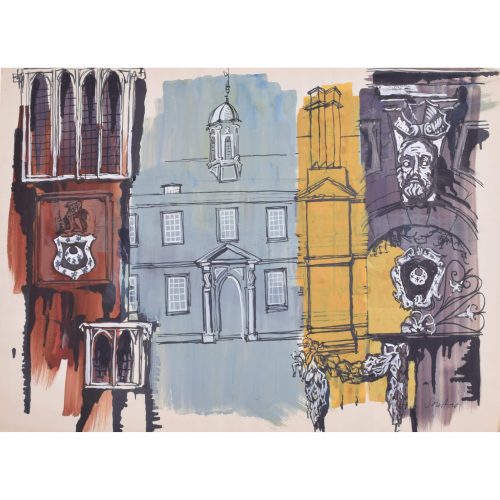
Margaret Souttar (1914 - 1987)
Trinity Hall, Cambridge V
Acrylic paint 56 x 72 cm Signed lower right. Souttar was a Scottish painter and printmaker known for her images of town- and cityscapes. In the early 1960s, she was commissioned to produce a series of prints of the Cambridge colleges. She captures the modernity and optimism of 1960s Cambridge; the fact that a female artist was commissioned to create the prints reflects the changing attitudes of the University towards women. Trinity Hall was one of the first Cambridge colleges to admit women as students – it did not do so until 1976. Provenance: the artist's studio sale. Condition: generally very good. If you are interested, please email info@manningfineart.co.uk or call us on 07929 749056. Click here for other views of Trinity Hall. -
Out of stock
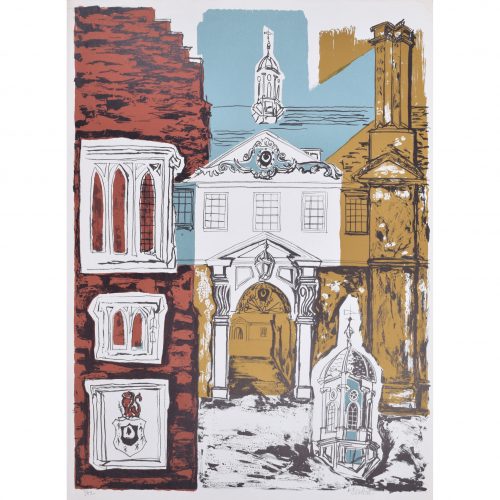
Margaret Souttar (1914 - 1987)
Trinity Hall, Cambridge with Blue Sky
Lithograph 76 x 56 cm Numbered 3/50, and signed lower right, in pencil. Souttar was a Scottish painter and printmaker known for her images of town- and cityscapes. In the early 1960s, she was commissioned to produce a series of prints of the Cambridge colleges. She captures the modernity and optimism of 1960s Cambridge; the fact that a female artist was commissioned to create the prints reflects the changing attitudes of the University towards women. Trinity Hall was one of the first Cambridge colleges to admit women as students - it did not do so until 1976. Provenance: the artist's studio sale. Condition: generally very good, the odd very short tear and handling mark affecting outer few millimetres of margin. If you are interested, please email info@manningfineart.co.uk or call us on 07929 749056. Click here for other views of Trinity Hall. -
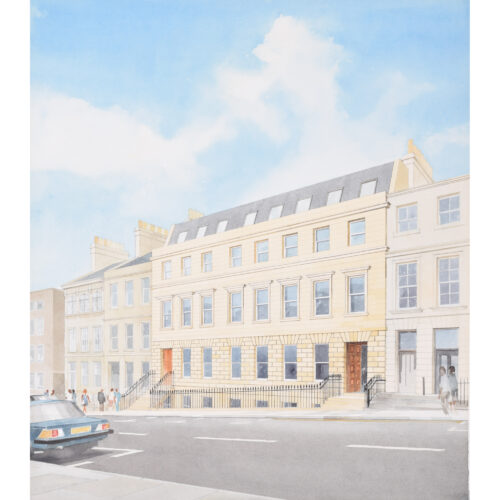
Alexander Duncan Bell (1930 - ?)
Troon House, St Vincent Street, Glasgow (1981)
Watercolour 62 x 54 cm For Hugh Martin & Partners, 3 September 1981. Bell's view of Troon House on St Vincent Street - the street is known for its grand and traditional architectural style. Pedestrians mill in this 1980s portrayal of Troon House, in use today as an office building. It was designed in 1980 by High Martin & Partners, the architectural firm for whom the artist worked. Condition: generally very good; old tape reside to extreme margins beyond image. If you are interested, please email info@manningfineart.co.uk or call us on 07929 749056. Click here for more architectural designs. -
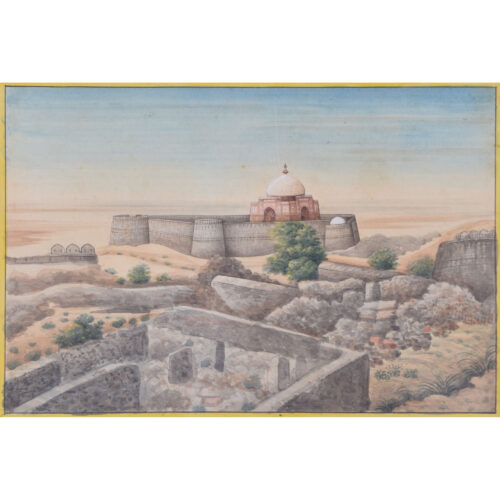
Tughlaqabad Fort, Delhi
Watercolour 13 x 20 cmA 20th century watercolour by an unknown artist of Tughlaqabad Fort, a ruined 14th-century fort in Delhi. We have three other Indian architectural views by the same artist available.Condition: generally very good; one or two small scratches as visible in photographs. If you are interested, please email info@manningfineart.co.uk or call us on 07929 749056. Click here for other works from the same series. -
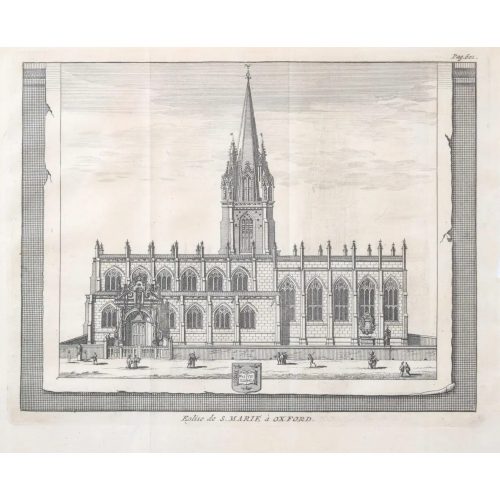
Pieter van der Aa (1659-1733), after David Loggan (1634–1692)
The University Church of St Mary the Virgin, University of Oxford (1727)
Engraving 12 x 16 cm An eighteenth-century view of the University Church, engraved by Pieter van der Aa after David Loggan, the noted engraver, draughtsman, and painter. St Mary's was the first building of the University of Oxford and its parish consists almost exclusively of university and college buildings. Its eccentric Baroque porch, designed by Nicholas Stone, faces the High Street, and it boasts a spire which is claimed by some church historians to be one of the most beautiful in England. Radcliffe Square lies to the north and to the east is Catte Street. The 13th-century tower is open to the public and provides magnificent views across the heart of the historic university city, especially Radcliffe Square, the Radcliffe Camera, Brasenose College, and All Souls College. Of particular interest here is the trompe l'oeil piece of gently torn paper which frames the view of the church. Pieter van der Aa of Leiden was a Dutch publisher best known for preparing maps and atlases, though he also printed editions of foreign bestsellers and illustrated volumes. He is noted for the many engravings he produced after David Loggan's series of Oxford and Cambridge colleges and costumes. In 1727 Van Der Aa illustrated "Les Delices de la Grande Bretagne & de L'Irelande" by James Beeverell, the book in which this engraving appears. Condition: a good impression. If you’d like to know more, please email info@manningfineart.co.uk or call us on 07929 749056. -
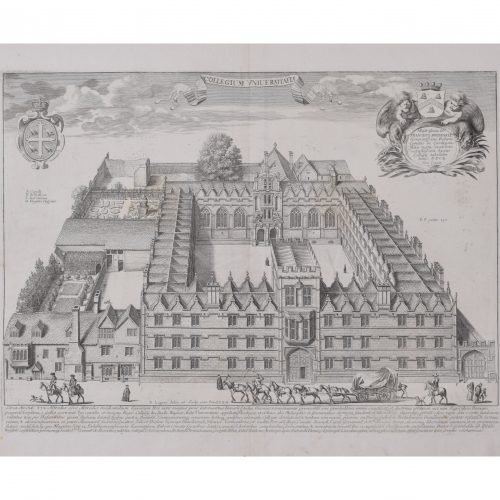
David Loggan (1634 - 1692)
University College, Oxford (1675)
Engraving 29 x 40 cm Loggan's view of Univ from the 'Oxonia Illustrata'. Loggan was born to English and Scottish parents, and was baptised in Danzig in 1634. After studying engraving in Danzig with Willem Hondius (1598-1652 or 1658), he moved to London in the late 1650s, going on to produce the engraved title-page for the folio 1662 Book of Common Prayer. He married in 1663 and moved to Nuffield in Oxfordshire in 1665. Loggan was appointed Public Sculptor to the nearby University of Oxford in the late 1660s, having been commissioned to produce bird’s-eye views of all the Oxford colleges. He lived in Holywell Street as he did this. The 'Oxonia Illustrata' was published in 1675, with the help of Robert White (1645 - 1704). Following its completion, Loggan began work on his equivalent work for Cambridge; the 'Cantabrigia Illustrata' was finally published in 1690, when he was made engraver to Cambridge University. The 'Oxonia Illustrata' also includes an engraving of Winchester College (Winchester and New College share William of Wykeham as their founder) whilst the 'Cantabrigia Illustrata' includes one of Eton College (which shares its founder, Henry VIII, with King’s College). Bird’s-eye views from this era required a particular talent as an architectural perspectivist; it was not until 1783 that it became possible for artists to ascend via hot air balloons and view the scenes they were depicting from above. Loggan thus had to rely on his imagination in conceiving the views. Loggan’s views constitute the first accurate depictions of the two Universities, in many ways unchanged today. Whilst the Oxford engravings were produced in reasonable numbers and ran to a second edition by Henry Overton (on thicker paper and with a plate number in Roman numerals in the bottom right-hand corner), those of Cambridge were printed in much smaller numbers. The Dutchman Pieter van der Aa published some miniature versions of the engravings for James Beverell’s guidebook to the UK, 'Les Delices de la Grande Bretagne' (circa 1708). The contemporary artist Andrew Ingamells has produced a highly-acclaimed series of etchings which bring Loggan’s original vision up to date. Condition: generally very good. If you’d like to know more, please email info@manningfineart.co.uk or call us on 07929 749056. -
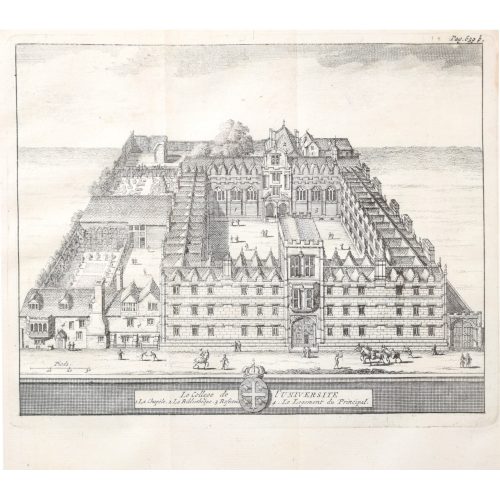
Pieter van der Aa (1659-1733), after David Loggan (1634–1692)
University College, Oxford (1727)
Engraving 12 x 16 cm An eighteenth-century view of University College, Oxford, engraved by Pieter van der Aa after David Loggan, the noted engraver, draughtsman, and painter. Pieter van der Aa of Leiden was a Dutch publisher best known for preparing maps and atlases, though he also printed editions of foreign bestsellers and illustrated volumes. He is noted for the many engravings he produced after David Loggan's series of Oxford and Cambridge colleges and costumes. In 1727 Van Der Aa illustrated "Les Delices de la Grande Bretagne & de L'Irelande" by James Beeverell, the book in which this engraving appears. Condition: a good impression. If you’d like to know more, please email info@manningfineart.co.uk or call us on 07929 749056. -
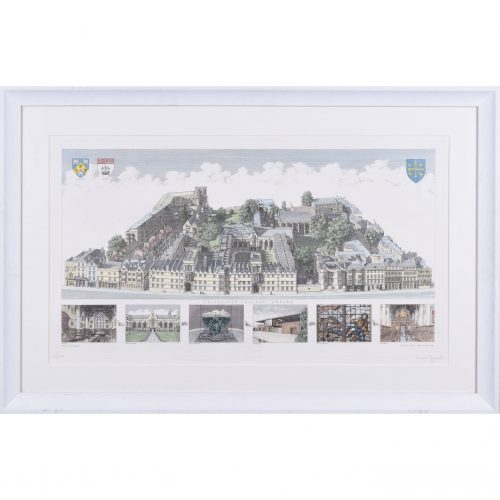
Andrew Ingamells (1956 - )
University College, Oxford
Etching 40 x 70 cm Signed lower right and numbered 15/100 lower left, both in pencil. Inspired by David Loggan’s celebrated engraving of the college, this view of Univ College belongs to Ingamells’ series of views of Oxford and Cambridge. The series took six months to complete and has long-since sold out from the publisher. Ingamells trained at St Albans School of Art and the London College of Printing, subsequently working as a graphic designer and illustrator. Based in London, he began making drawings of the buildings and landscapes of London. Ingamells’ work is in many public collections including those of the Tate Gallery, The National Trust, The Paul Mellon Centre for British Art, and the City of London Guildhall Library. His pictures are also in several private collections, including those of various Oxford and Cambridge colleges, HM King Charles III, and Shell Oil. The artist is currently part-way through his epic project to record all the colleges of Oxford and Cambridge, a project undertaken in homage to David Loggan. Condition: excellent. If you are interested, please email info@manningfineart.co.uk or call us on 07929 749056. Click here for other views of University College, Oxford. -
Out of stock
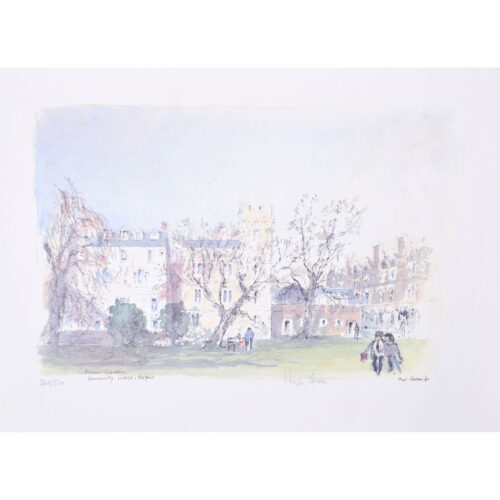
Hugh Casson (1910 - 1999)
The Fellows' Garden, University College, Oxford (1991)
Lithograph 28 x 38 cm Signed, titled and dated in plate, and numbered 249/500 and signed lower right in pencil. Casson's view of University College's Fellows' Garden. Members of the College sit or stroll, books in hand. Sir Hugh Casson was educated at Eastbourne College; St John’s College, Cambridge; and the Bartlett School of Architecture. Trained in the 1930s in the early modernist style, he taught at the Cambridge School of Architecture. After employment as a camoufleur during World War 2 by the Air Ministry, in 1948 he was appointed as director of architecture for the Festival of Britain. A close friend of the Royal Family, he undertook designs for the 1953 coronation, designed the interior of the Royal Yacht Britannia (“The overall idea was to give the impression of a country house at sea”), and taught the young Charles III to paint in watercolours. Amongst his architectural achievements are the Elephant House at London Zoo, the 1978 redevelopment of Bristol Docks, the Raised Faculty Building for The University of Cambridge, and a building for the Royal College of Art. He published a number of illustrated books, of which Casson’s Oxford and Casson’s Cambridge are probably the best known. A limited edition series of prints was produced from the paintings. Condition: very good. If you’d like to know more, please email info@manningfineart.co.uk or call us on 07929 749056. Click here for other views of University College, Oxford. -
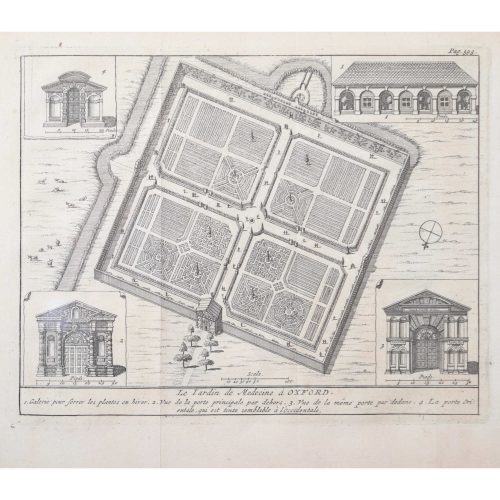
Pieter van der Aa (1659-1733), after David Loggan (1634–1692)
The University of Oxford Botanic Garden (1727)
Engraving 12 x 16 cm An eighteenth-century view of one of Oxford's dreamiest spaces: the Botanic Garden, engraved by Pieter van der Aa after David Loggan, the noted engraver, draughtsman, and painter. The University of Oxford Botanic Garden was founded in 1621 and is the oldest botanical garden in Great Britain. van der Aa's engraving focuses on its architectural qualities, with four features of the garden highlighted for their beauty, symmetry, and prowess of design. Of particular interest in this etching are the four trompe l'oeil pieces of gently curling paper which frame the gates of the garden. The Danby Gate (bottom left) at the front entrance to the garden is one of the three entrances designed by Nicholas Stone between 1632 and 1633. The gateway consists of three bays, each with a pediment; the niches contain statues of Charles I and Charles II in classical pose, and the niche in the the central pediment contains a bust of the Earl of Danby (hence the gate's name). Pieter van der Aa of Leiden was a Dutch publisher best known for preparing maps and atlases, though he also printed editions of foreign bestsellers and illustrated volumes. He is noted for the many engravings he produced after David Loggan's series of Oxford and Cambridge colleges and costumes. In 1727 Van Der Aa illustrated "Les Delices de la Grande Bretagne & de L'Irelande" by James Beeverell, the book in which this engraving appears. Condition: a good impression. If you’d like to know more, please email info@manningfineart.co.uk or call us on 07929 749056. -
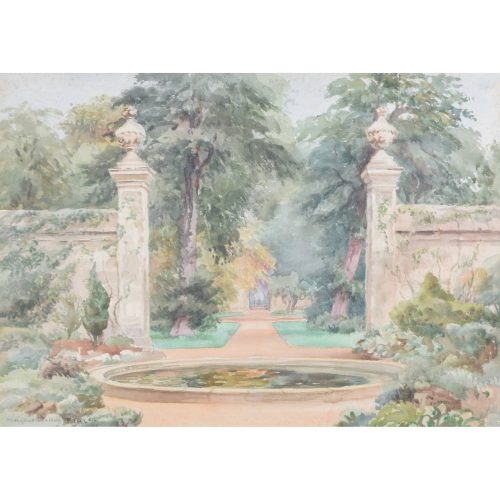
Margaret Waller (1916 - 1997)
The Oxford University Botanic Garden
Watercolour 35 x 51 cm Signed lower left. A watercolour depicting the serenity of Oxford's Botanic Garden. Koi swim just below the surface of the round pond and the garden stretches into the distance through a pair of stone arches. Margaret Waller was a mid-century artist and Fellow of the Institute of Arts and Letters. Condition: generally good; a little spotting to the sky. 'FIAL' added to signature later. If you are interested, please email info@manningfineart.co.uk or call us on 07929 749056. Click here for other non-collegiate views of Oxford. -
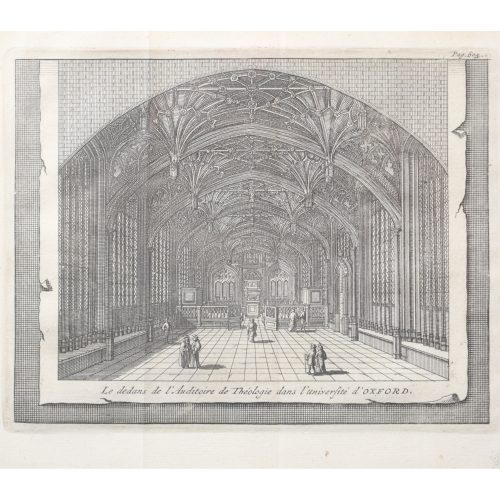
Pieter van der Aa (1659-1733), after David Loggan (1634–1692)
The Divinity School, University of Oxford
Engraving (1727) 12 x 16 cm An eighteenth-century view of Oxford's medieval Divinity School, which was once the beating heart of theological studies at the University. The scene is engraved by Pieter van der Aa after David Loggan, the noted engraver, draughtsman, and painter. Of particular interest here is the trompe l'oeil piece of torn paper which frames the Divinity School view. Pieter van der Aa of Leiden was a Dutch publisher best known for preparing maps and atlases, though he also printed editions of foreign bestsellers and illustrated volumes. He is noted for the many engravings he produced after David Loggan's series of Oxford and Cambridge colleges and costumes. In 1727 Van Der Aa illustrated "Les Delices de la Grande Bretagne & de L'Irelande" by James Beeverell, the book in which this engraving appears. Condition: a good impression. If you are interested, please email info@manningfineart.co.uk or call us on 07929 749056. -
Out of stock
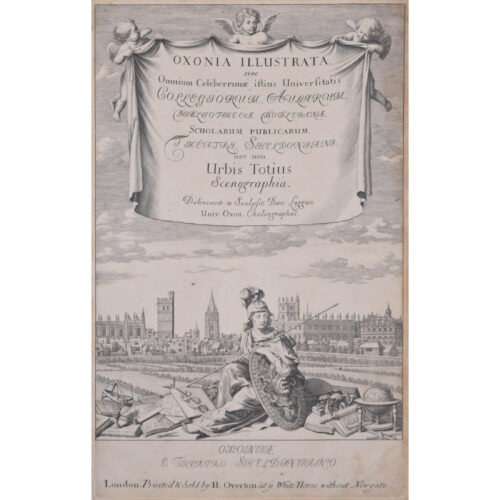
David Loggan (1634 - 1692)
Frontispiece to the Oxonia Illustrata (1675)
Engraving 38 x 24 cm The intricately engraved frontispiece to Loggan's 'Oxonia Illustrata', featuring cherubs bearing the volume's title on a banner and Minerva, goddess of wisdom, sitting before a panorama of Oxford's resplendent architecture. David Loggan's view of Oxford's medieval Divinity School, which was once the beating heart of theological studies at the University. Of particular interest here is the trompe l'oeil scroll of torn paper which frames the view. Loggan was born to English and Scottish parents, and was baptised in Danzig in 1634. After studying engraving in Danzig with Willem Hondius (1598-1652 or 1658), he moved to London in the late 1650s, going on to produce the engraved title-page for the folio 1662 Book of Common Prayer. He married in 1663 and moved to Nuffield in Oxfordshire in 1665. Loggan was appointed Public Sculptor to the nearby University of Oxford in the late 1660s, having been commissioned to produce bird’s-eye views of all the Oxford colleges. He lived in Holywell Street as he did this. The 'Oxonia Illustrata' was published in 1675, with the help of Robert White (1645-1704). Following its completion, Loggan began work on his equivalent work for Cambridge; the 'Cantabrigia Illustrata' was finally published in 1690, when he was made engraver to Cambridge University. The 'Oxonia Illustrata' also includes an engraving of Winchester College (Winchester and New College share William of Wykeham as their founder) whilst the 'Cantabrigia Illustrata' includes one of Eton College (which shares its founder, Henry VIII, with King’s College). Bird’s-eye views from this era required a particular talent as an architectural perspectivist; it was not until 1783 that it became possible for artists to ascend via hot air balloons and view the scenes they were depicting from above. Loggan thus had to rely on his imagination in conceiving the views. Loggan’s views constitute the first accurate depictions of the two Universities, in many ways unchanged today. Whilst the Oxford engravings were produced in reasonable numbers and ran to a second edition by Henry Overton (on thicker paper and with a plate number in Roman numerals in the bottom right-hand corner), those of Cambridge were printed in much smaller numbers. The Dutchman Pieter van der Aa published some miniature versions of the engravings for James Beverell’s guidebook to the UK, 'Les Delices de la Grande Bretagne' (circa 1708). The contemporary artist Andrew Ingamells (born 1956) has produced a highly-acclaimed series of etchings which bring Loggan’s original vision up to date. Condition: trimmed within platemark and mounted to board, otherwise in very good condition. If you are interested, please email info@manningfineart.co.uk or call us on 07929 749056. Click here for other general views of Oxford.

